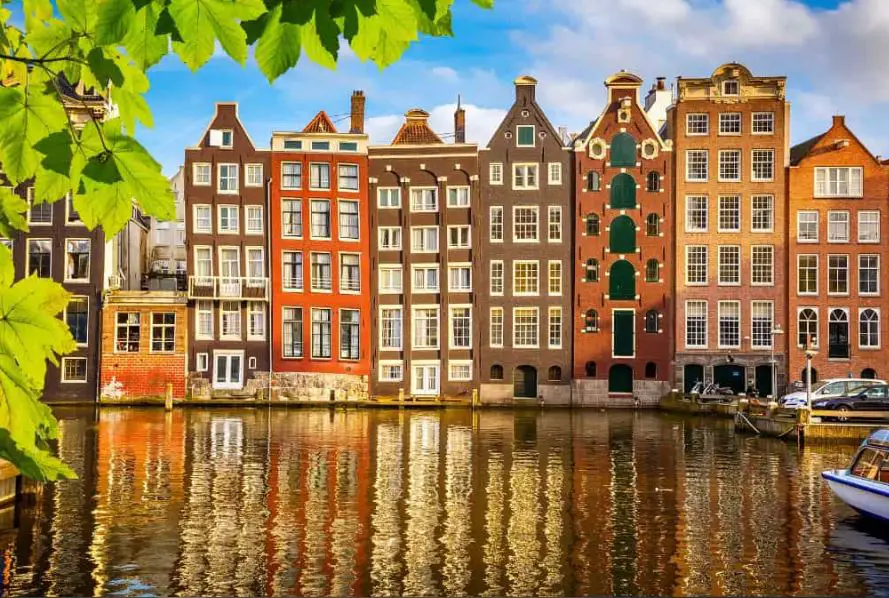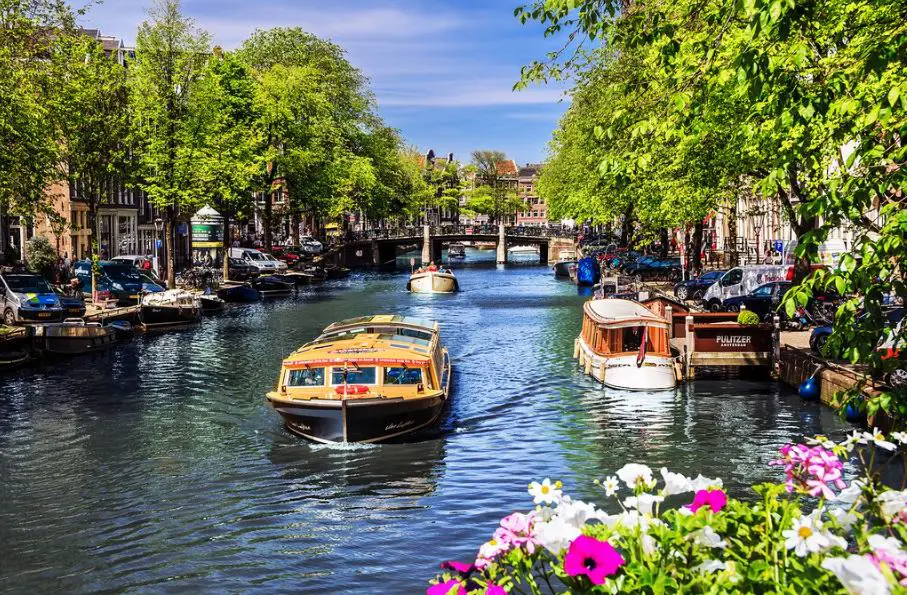The Netherlands, often referred to as Holland, is a small yet remarkable country nestled in Northwestern Europe. Despite its modest size, it boasts a rich tapestry of culture, history, and innovation. From picturesque tulip fields to iconic windmills, here are 20 incredible things the Netherlands is known for.
1. Tulip Fields: A Vibrant Spectacle
Dotted across the Dutch countryside, the vibrant tulip fields are a sight to behold. The Netherlands is renowned for its tulips, which have been cultivated since the 16th century. These colorful blooms symbolize beauty and prosperity and are celebrated annually during the Tulip Festival.
History and Significance
The Dutch tulip mania of the 17th century sparked the world’s first economic bubble, making tulip bulbs a prized commodity. Today, the Netherlands remains the largest producer of tulips globally.
Annual Tulip Festivals
Each spring, visitors flock to the Keukenhof Gardens and other locations to witness the stunning display of tulips in full bloom. The Tulip Festival showcases a kaleidoscope of colors, with millions of bulbs carpeting the landscape.
2. Windmills: Iconic Dutch Structures
Windmills are synonymous with the Dutch landscape, serving as iconic symbols of the country’s heritage and ingenuity. These traditional structures have played a vital role in various industries throughout history.
Historical Significance
In the past, windmills were used for tasks such as pumping water, grinding grain, and sawing timber. They enabled the Dutch to reclaim land from the sea and harness wind power for productivity.
Modern-Day Use
While many historic windmills remain operational, others have been repurposed as museums or residences. Additionally, the Netherlands is at the forefront of wind energy technology, with modern wind turbines dotting the horizon.
3. Canals of Amsterdam: The Venice of the North
Amsterdam’s picturesque canals are a defining feature of the cityscape, earning it the nickname “Venice of the North.” These waterways offer a unique perspective of Amsterdam’s historic architecture and vibrant neighborhoods.
History of Canal Construction
During the Dutch Golden Age, a network of canals was constructed to facilitate trade and transportation. Today, these UNESCO-listed canals provide a charming backdrop for leisurely boat tours and romantic strolls.
Sightseeing and Boat Tours
Exploring Amsterdam by boat is a quintessential experience for visitors. From guided canal cruises to self-paddled kayaks, there are numerous ways to admire the city’s landmarks from the water. Guided tours in Amsterdam.
4. Cycling Culture: Pedaling Paradise
The Netherlands is renowned for its cycling-friendly infrastructure and widespread adoption of bicycles as a primary mode of transportation. Cycling is ingrained in Dutch culture, offering numerous benefits for individuals and the environment.
Bike-Friendly Infrastructure
Cities like Amsterdam and Utrecht boast extensive networks of bike lanes, making cycling safe and convenient for commuters and leisure riders alike. Cyclists enjoy priority on the roads, with dedicated traffic signals and parking facilities.
Health and Environmental Benefits
Cycling promotes physical activity, reducing the risk of obesity and cardiovascular disease. Moreover, it helps mitigate air pollution and traffic congestion, contributing to cleaner and more sustainable urban environments.
5. Cheese Markets: Gouda Galore
The Netherlands is famous for its rich tradition of cheese-making, with varieties like Gouda, Edam, and Leiden gaining international acclaim. Cheese markets offer a glimpse into this centuries-old craft, attracting visitors from around the world.
Traditional Cheese-Making
Cheese production in the Netherlands dates back to the Middle Ages, with farmers utilizing local milk and traditional techniques to create artisanal cheeses. Gouda, named after the city of the same name, is among the most popular varieties.
Famous Cheese Markets
Historic cities like Alkmaar and Gouda host weekly cheese markets where traders in traditional attire haggle over wheels of cheese. These lively events feature cultural performances, tasting sessions, and demonstrations of cheese-making skills.
6. Dutch Masters: Artistic Legacy
The Netherlands has produced some of the world’s most renowned painters, known as the Dutch Masters. Artists like Rembrandt van Rijn and Johannes Vermeer have left an indelible mark on the art world with their masterful creations.
Renowned Painters like Rembrandt and Vermeer
Rembrandt’s chiaroscuro technique and Vermeer’s meticulous attention to detail are hallmarks of Dutch Golden Age painting. Their works, including “The Night Watch” and “Girl with a Pearl Earring,” continue to captivate audiences worldwide.
Museum Collections
The Netherlands boasts an impressive array of art museums housing masterpieces by Dutch Masters and other renowned artists. The Rijksmuseum in Amsterdam and the Mauritshuis in The Hague are among the must-visit institutions for art enthusiasts. Check this Website: Triggertours.com for Dutch tour.
7. Diverse Cuisine: Beyond Stroopwafels
While stroopwafels and herring are quintessential Dutch snacks, the Netherlands offers a diverse culinary landscape influenced by global flavors. From hearty stamppot to indulgent Dutch pancakes, there’s something to satisfy every palate.
Traditional Dishes like Stroopwafels and Herring
Stroopwafels, thin waffle cookies filled with caramel syrup, are a beloved Dutch treat enjoyed with coffee or tea. Herring, typically served raw with onions and pickles, is a staple street food often enjoyed at fish stands.
Indonesian Influence
The Netherlands’ colonial history has left a lasting culinary legacy, with Indonesian cuisine being particularly popular. Dishes like nasi goreng (fried rice) and satay skewers reflect the fusion of Dutch and Indonesian flavors.
8. Tolerance and Diversity: Progressive Values
The Netherlands has long been celebrated for its progressive stance on social issues, including tolerance and diversity. It is known for its inclusive policies and vibrant LGBTQ+ community.
History of Tolerance
The Dutch Republic was one of the first countries to legalize same-sex marriage in 2001, paving the way for LGBTQ+ rights worldwide. Amsterdam, in particular, has a reputation for its open-mindedness and acceptance of diverse lifestyles.
LGBTQ+ Rights
The Netherlands ranks among the most LGBTQ+-friendly countries, with anti-discrimination laws and comprehensive healthcare services for queer individuals. Annual events like Amsterdam Pride celebrate diversity and promote inclusivity.
9. Innovations in Water Management: Battling the Sea
With much of its territory situated below sea level, the Netherlands has become a global leader in water management and flood protection. Innovative solutions have enabled the Dutch to reclaim land from the sea and mitigate the risks of flooding.
Polders and Dikes
The Dutch have constructed an extensive network of polders—low-lying areas enclosed by dikes—to reclaim land from marshes and bodies of water. These reclaimed lands are used for agriculture, residential development, and recreation.
Water Management Technology
Advanced technologies such as storm surge barriers and floodgates help safeguard the Netherlands against rising sea levels and extreme weather events. The Delta Works, a series of engineering marvels, exemplifies the country’s commitment to water resilience.
10. Legalized Cannabis: A Liberal Stance
The Netherlands is known for its progressive approach to drug policy, particularly regarding the legalization of cannabis. While cannabis remains technically illegal, the sale and consumption of small quantities are tolerated in designated establishments known as coffee shops.
History of Cannabis Policy
In the 1970s, the Dutch government implemented a policy of tolerance toward soft drugs like cannabis, distinguishing between legal and illegal substances. This approach aimed to separate the cannabis market from the illicit drug trade.
Coffee Shops and Regulations
Coffee shops in the Netherlands are licensed to sell cannabis products for personal use, with strict regulations governing their operation. Customers must be aged 18 or older, and purchases are limited to specified quantities per transaction.
11. Delftware: Elegant Blue Pottery
Delftware, also known as Delft Blue, is a distinctive style of pottery originating from the city of Delft in the Netherlands. Characterized by its blue and white motifs, Delftware has been prized for its craftsmanship and aesthetic appeal for centuries.
History of Delftware Production
Delftware gained popularity in the 17th century as a more affordable alternative to Chinese porcelain. Dutch artisans adapted traditional Chinese techniques to create their own unique designs, featuring scenes of Dutch landscapes and floral motifs.
Modern-Day Craftsmanship
While traditional Delftware factories still operate in Delft, contemporary artisans have reinterpreted this iconic style to suit modern tastes. Delftware remains a cherished symbol of Dutch heritage, with collectors worldwide coveting rare pieces.
12. Dutch Design: Sleek and Functional
Dutch design is renowned for its minimalist aesthetic, functional approach, and emphasis on innovation. From architecture to furniture, Dutch designers have made significant contributions to the global design landscape.
Influence on Architecture and Product Design
Dutch architects like Rem Koolhaas and Piet Blom are known for their avant-garde designs that challenge conventional norms. The Cube Houses in Rotterdam and the Amsterdam School architectural style exemplify the Dutch commitment to innovative design.
World-Renowned Designers
Designers such as Marcel Wanders and Hella Jongerius have gained international acclaim for their distinctive creations that blend form and function. Dutch design brands like Droog and Moooi are synonymous with creativity and craftsmanship.
13. King’s Day Celebrations: A Sea of Orange
King’s Day, or Koningsdag, is a festive national holiday celebrated throughout the Netherlands in honor of the reigning monarch’s birthday. The streets come alive with vibrant orange decorations, street markets, and lively festivities.
History and Traditions
Originally known as Princess’s Day, the holiday was established in 1885 to celebrate the birth of Princess Wilhelmina. Following her accession to the throne, it became Queen’s Day and, later, King’s Day when Willem-Alexander became king.
Street Parties and Festivities
On King’s Day, Dutch cities and towns are transformed into bustling outdoor carnivals, with residents donning orange attire and participating in street parties and parades. The day is marked by music performances, flea markets, and traditional games.
14. Global Trade Hub: Rotterdam Port
Rotterdam Port is the largest seaport in Europe and one of the busiest in the world, serving as a vital hub for global trade and logistics. Its strategic location and state-of-the-art facilities make it an indispensable link in the international supply chain.
Busiest Port in Europe
Rotterdam Port handles millions of tons of cargo annually, including containers, bulk goods, and petroleum products. Its extensive network of shipping routes connects Europe to destinations worldwide, facilitating trade and commerce.
Economic Significance
The port’s economic impact extends far beyond the Netherlands, generating billions of euros in revenue and supporting thousands of jobs. It serves as a gateway to European markets and a key transit point for goods traveling between continents.
15. Dutch Royal Family: Symbol of Unity
The Dutch Royal Family plays a significant role in the nation’s identity, serving as a symbol of unity and continuity. With a rich history dating back centuries, the monarchy remains deeply ingrained in Dutch culture and tradition.
History of the Monarchy
The House of Orange-Nassau has ruled the Netherlands since the establishment of the Dutch Republic in the 16th century. The current monarch, King Willem-Alexander, ascended to the throne in 2013 following the abdication of his mother, Queen Beatrix.
Modern-Day Role
While the Dutch monarchy is largely ceremonial, the royal family fulfills important symbolic duties, representing the nation at official events and state functions. The king and queen also engage in charitable work and diplomatic endeavors to promote Dutch interests abroad.
16. World-Class Education: A Hub for Learning
The Netherlands is renowned for its high-quality education system, which consistently ranks among the best in the world. Its universities and research institutions attract students and scholars from across the globe.
Internationally-Ranked Universities
Dutch universities excel in various fields, from engineering and science to humanities and social sciences. Institutions like Delft University of Technology and University of Amsterdam are renowned for their academic excellence and research contributions.
Educational System Overview
The Dutch education system emphasizes student-centered learning, critical thinking, and practical skills development. Higher education is accessible and affordable, with numerous scholarship opportunities available for international students.
17. Innovation and Technology: Silicon Canals
The Netherlands has emerged as a hotbed of innovation and technology, earning the nickname “Silicon Canals” for its thriving startup ecosystem. From fintech to biotech, Dutch startups are making waves on the global stage.
Startup Ecosystem
Cities like Amsterdam and Eindhoven are home to vibrant startup communities, fueled by supportive government policies, access to capital, and a culture of entrepreneurship. Co-working spaces, incubators, and accelerators provide fertile ground for startups to grow and thrive.
Tech Innovations
Dutch startups are at the forefront of technological innovation, developing solutions in areas such as sustainable energy, artificial intelligence, and healthcare. Initiatives like StartupDelta and TechLeap.nl support the growth of innovative startups and attract investment to the Netherlands.
FAQs
Is it true that tulips are native to the Netherlands?
While tulips are often associated with the Netherlands, they originated in Central Asia and were introduced to Europe in the 16th century.
What is the significance of the color orange in Dutch culture?
Orange is the color of the Dutch Royal Family, stemming from the House of Orange-Nassau’s historical ties to the Netherlands.
Are coffee shops the only places where cannabis is sold in the Netherlands?
Yes, coffee shops are the only establishments licensed to sell cannabis for personal use in the Netherlands.
What is the most popular cheese in the Netherlands?
Gouda is the most famous Dutch cheese, known for its mild flavor and creamy texture.
How many provinces are there in the Netherlands?
The Netherlands is divided into 12 provinces, each with its own distinct culture and geography.
Conclusion
The Netherlands is a land of contrasts, where traditional heritage coexists with modern innovation. From tulip fields and windmills to progressive values and cutting-edge technology, the Dutch experience offers something for everyone to admire and appreciate.




Leave a Reply